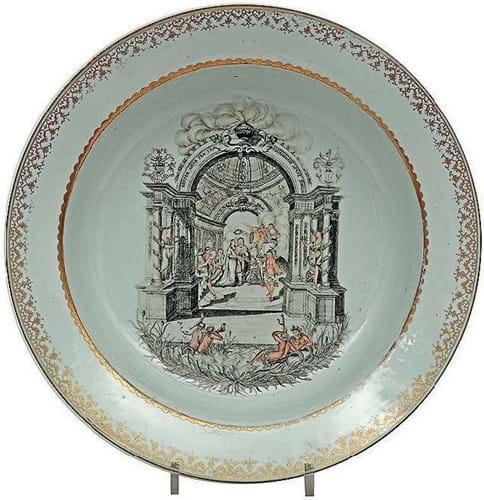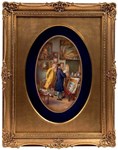
Early 18th century Chinese blue and white Baptism of Christ bowl, €18,000 (£16,000) at DVC Auctions in Ghent.
From the 16th to the 18th centuries Christian missionaries played a significant role in the transmission of knowledge, science, and culture between China and the West.
Famously it was Jesuits that introduced the Qing court to the technology necessary for enamelling on porcelain.
One of the consequences of this was the range of porcelain known as Jesuit ware.
Predominantly made in the reign of Qianlong (1736-96) for export via Portuguese traders, it is typically decorated en grisaille and gilt with subject matter taken from European engravings.
A rarer series of wares from the 1720s are those with blue and white decoration.
These include a group of large 18in (45cm) bowls painted to the centre with a scene of the baptism of Christ.
He is shown as a young man standing with John the Baptist at the water’s edge with the Holy Ghost represented as an ascending angel.
The border of fruit and cherubs includes the inscription Mat 3.16 – a reference to the relevant passage in the New Testament.
A dish from the Mottahedeh collection, dated to c.1725, is pictured in David Howard and John Ayers’ China for the West, where it is noted that “it is possible that this ware was made for use in China and Japan and was only incidentally exported to Europe as a curiosity or as evidence of the missionary work being done”.
Auction examples
A similar example sold for £26,000 at Woolley & Wallis in Salisbury back in 2013 and another appeared at DVC Auctions (26% buyer’s premium) in Ghent, Belgium, on March 4.
It was estimated at just €500-1500 but sold at €18,000 (£16,000).
In the same auction a fine example of Qianlong period Jesuit porcelain sold at €16,000 (£14,000) against similar expectations.
This large welled dish measuring 17in (42cm) across is decorated with a multi-figure allegorical scene of a marriage set in a baroque chapel.
A similar dish is in the collection of the National Museum of Decorative Arts in Buenos Aires.















